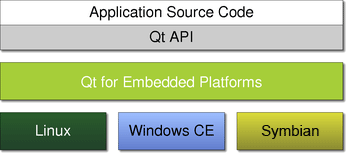
Qt is available for embedded platforms and devices as well as for a number of desktop platforms. The features provided for each platform depend on the capabilities and architecture of the operating system.

Currently, three embedded platforms are supported by Qt:
| Embedded Linux | Windows CE | Symbian platform |
|---|---|---|
| Qt for Embedded Linux is designed to be used on Linux devices without X11 or existing graphical environments. This flavor of Qt includes a framework for creating both applications and an environment for them. As a result, it includes features for window management, inter-process communication and facilities for handling input and display devices. | Qt for Windows CE is used to create applications running in existing Windows CE and Windows Mobile environments. Applications use the appropriate style for the embedded environment and use native features, such as menus, to conform to the native style guidelines. | Qt for the Symbian platform is used to create applications running in existing Symbian platform environments. Applications use the appropriate style for the embedded environment and use native features, such as menus, to conform to the native style guidelines. |
© 2008-2011 Nokia Corporation and/or its subsidiaries. Nokia, Qt and their respective logos are trademarks of Nokia Corporation in Finland and/or other countries worldwide.
All other trademarks are property of their respective owners. Privacy Policy
Licensees holding valid Qt Commercial licenses may use this document in accordance with the Qt Commercial License Agreement provided with the Software or, alternatively, in accordance with the terms contained in a written agreement between you and Nokia.
Alternatively, this document may be used under the terms of the GNU Free Documentation License version 1.3 as published by the Free Software Foundation.


